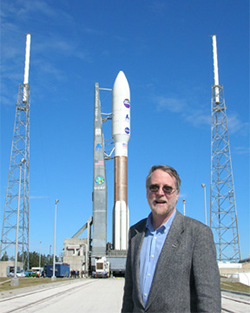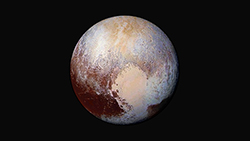
| Vol.
XXVIII No.
1 September / October 2015 |
| contents |
| Printable Version |
Pluto In View! O! The Joy!
The following Q&A by the Faculty Newsletter (FNL) was held with MIT professor Richard Binzel (RB), a co-investigator on NASA's New Horizons mission to Pluto and the Kuiper belt.
A career-long odyssey in the study of Pluto, getting a mission to the launch pad, and a successful flyby after a decade of interplanetary flight.
FNL: According to news reports, you were part of a group that began proposing a Pluto mission 25 years ago, which was cancelled six times before finally launching in 2006. What is it like to keep at this goal for so long and how did you maintain your determination?
RB: Well, beyond the trademark persistence that permeates all of us here at MIT, it is the raw spirit of exploration to “reach the unreachable” that fueled my determination. During one of the many downturns you mention, I happened to pick up Stephen Ambrose’s Undaunted Courage, the story of the Lewis and Clark expedition. The parallel went right to my core: the determination and effort required to get across the continent 200 years ago was exactly what we had to muster to reach that next frontier across the solar system. In my office I put up a painting depicting the Lewis and Clark journey and I read their journals day-by-day. In getting to Pluto, every day became just one more step in a journey of exploration.
FNL: How did you first get involved with a Pluto mission?
RB: The success of Voyager 2 reaching Neptune in 1989 signaled that Pluto could be in reach of a spacecraft. At that time, I was one of only a handful of Pluto scientists worldwide. We happened to be together at a conference in Baltimore in May 1989. Over dinner our discussions turned to the concept of a Pluto mission. Our conclusion: Why not now? Why not us? The die was cast, and most strongly with Alan Stern who would become the New Horizons Principal Investigator. I cannot give enough credit to Alan and the team he assembled over the years to make this mission a success. In the end, I am just a small member of the team.
FNL: If there were so few Pluto scientists, how is it that Pluto captured your scientific interest to begin with?
RB: Like many things, it was happenstance that goes back to 1978 when I was an undergraduate. I was a summer “UROP” (which hadn’t been invented yet) working at the U.S. Naval Observatory in Washington, DC. Pluto’s large moon (Charon) was literally discovered in the office next door during the first week of my internship. On the very day of discovery (June 22, 1978), I was there along side the professionals examining the fuzzy telescopic images of Pluto on glass photographic plates. A persistent bump on the photographs moved around Pluto that fit its known 6.4 days rotation period. So from the very beginning of my career I was there helping to calculate the rotationally synchronous orbit of Pluto’s moon. Even that minor participation in such a major discovery yielded a very powerful lesson: Even what seems unknowable can be unraveled.
FNL: Based on your own research, what did you expect to see on Pluto and what surprised you the most?
RB: In graduate school I began my own Pluto observations that led to the detection of “eclipses” between Pluto and its moon. Again this was a fortuitous once-per-century alignment, but the passing of Charon across Pluto’s disk (like a scanner) allowed us to directly map the surface of Pluto long before the Hubble Space Telescope did it. Happily, as it turns out, those maps proved quite correct within their limits, revealing bright polar regions and an overall darker equatorial band. Surprising us in situ was the starkness in the contrast – having icy regions as bright as we see means they have to be geologically recent deposits. Together with my graduate student, we are trying to figure out exactly how seasons work on Pluto. The driving forces are its 248-year elliptical orbit changing the global solar insolation it receives by a factor of two and the fact its spin vector is tilted over by about 60 degrees with a precession period of a few million years.
FNL: What were some of the most daunting technical challenges to reach Pluto?
RB: Space flight is hard and the great distance makes everything even harder. To reach the destination in a survivable lifetime for both the team and the spacecraft requires flight at high velocity (more than 20 km/sec). But at that velocity, we can’t carry enough fuel to slow down and orbit. So everything had to be done as a flyby, and with a nine-hour communication delay (light-time travel 4.5 hours each way), it all had to be completely autonomous. The autonomous flyby requirement dictated every aspect of the instrument design down to the most minute detail for choreographing our data acquisition and storage during closest approach. Solar panels are not effective at that distance, meaning we needed a radioisotope (plutonium, of course) to generate power. Getting that fueled and the approval process completed in time for launch was a huge hurdle. Our data return rate from Pluto’s distance (and only 40 watts of power) is 1000 bits per second, reminiscent of a dial-up modem with an acoustic coupler. So now, it is a patient process to get all of the data down to Earth.
FNL: How much did the New Horizons mission cost? Did Pluto’s reclassification as a “Dwarf Planet” have any effect on the mission?
RB: New Horizons is a NASA-funded $700 million mission, placing it in the “mid-range” of planetary mission budgets. As for the label, this had no effect whatsoever other than rekindling public interest in Pluto. (For what it’s worth, the Sun is classified as a dwarf star.) Scientifically, we have always sought to explore Pluto as its own unique world, regardless of its label. Pluto itself has proved us right about being different! One enjoyable fallout was many engaging conversations with Jay Keyser on the linguistics of why labels are so difficult to define across many fields.

FNL: What was the most satisfying part of your experience?
RB: The most satisfying part was the human element of seeing the joy on the faces of one’s colleagues who have become a family during this long journey from concept to destination. We did it! In that journey, some of MIT’s own students (trained by the late Professor James Elliot) rose to the top ranks of Deputy Project Scientists -– and there is no joy greater than seeing our students succeed. Leslie Young (EAPS PhD ’94) [the daughter of retired Aero Astro Professor Larry Young] and Cathy Olkin (EAPS PhD ’96) are high level faces for at least one-quarter of the team who are women, which we think is the highest proportion on any NASA mission. It is very satisfying to know that New Horizons is pushing this frontier as well.
FNL: What advice do you give your students about taking on these kinds of challenges?
RB: Start early! Even a journey of 3 billion miles begins with a single step. Keep in your heart that spirit of exploration to steel yourself against how hard it is to reach unreachable frontiers.
FNL: What’s next?
RB: We have a healthy spacecraft continuing to fly through the Kuiper Belt, a newly recognized region beyond Neptune that is like an “asteroid belt” only even more populous. We have at least one known object (about 50 km across) in our sites that’s within our remaining fuel budget. We’ll soon be asking for NASA’s approval for an extended mission to go there.
FNL: Anything else you would like to add?
RB: Two things. First, we feel very privileged to be the capstone team for the generation completing the first reconnaissance of all the planets in our solar system, many aspects of which we owe to MIT colleagues. Mariner 4 flew by Mars exactly 50 years prior, and in those decades we have explored every planet from Mercury outward, including the largest main-belt asteroids. Second, we hope New Horizons becomes “the Apollo moment” for a new generation of young scientists and engineers. I guess we’ll find out when we quiz the entering class of 2030 about how they got interested in their careers.
| Back to top | |
| Send your comments |
| home this issue archives editorial board contact us faculty website |
